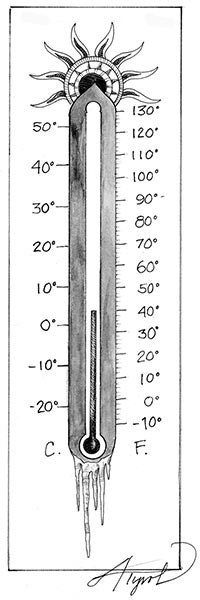
Many years ago, I lived in San José, California where the weather forecast went something like this: Sunny for three weeks, one day of rain, followed by many more weeks of sun. There was a sameness to the weather that bordered on the banal and never made me wonder what was going on.
Not so here in northern New England. The mercurial nature of our weather keeps us wondering from day to day – often hour to hour – when it’s going to change. The uncertainty is never more present than in the winter, when at times we’re blessed with that trifecta of miserable driving conditions: snow, sleet, and freezing rain.
Why is it that a day could start with a delicate snowfall and suddenly shift to a clattering sleet and end in an icy glaze – but the mercury doesn’t move? Or the temperature will be 30 degrees in both Claremont and Burlington, but snow will fall in one and freezing rain in the other? Clearly the thermometer is telling only part of the story.
The rest, it turns out, is being written in the air masses between the clouds and the earth’s surface. As Steve Maleski, a meteorologist at the Fairbanks Museum and Planetarium in St. Johnsbury explained, winter precipitation almost always starts as snow in the clouds. What it looks like when it hits the surface depends on what it encounters on the way down.
If ice crystals fall from cloud to ground in air that stays at or below 32 degrees, we get snow. If they hit warmer air all the way to the surface, we get rain.
It gets more complicated, said Maleski, when the ice crystals hit warm air and melt, but then hit another mass of subfreezing air on their way to the surface. The result will be sleet or freezing rain, depending on the temperature of the ice crystals when they melt and the depth of the sub-freezing air mass.
Let’s imagine two different scenarios, in which it’s 30 degrees outside your front door. In the first scenario, the first layer of subfreezing air (from the ground up) is one thousand feet deep and, above that, there’s a thick layer of air that is warmer than 32 degrees. In this case, the ice crystals hit that warm air and melt, and don’t have time to re-freeze before hitting the ground. The very cold water freezes upon contact, producing freezing rain.
In the second scenario, the freezing air mass above the surface is at least 2,000 feet deep. In this case, the ice crystals melt upon hitting the warm air, but then re-freeze as they fall through the colder layer. The ice crystals don’t convert back to snow, but fall as ice pellets, otherwise known as sleet.
Maleski noted that many other factors can play into the mixed-precipitation equation. For example, in the second scenario, if the warm air that melts the ice crystals is above 37 degrees, we could still get freezing rain instead of sleet, or a mix of the two.
Topography also figures into the equation. In places like the Champlain Valley, cold air, which is denser than warm air, has a tendency to settle in and stay. So when warm air blows in, generally from the south, the cold air tends to be stubborn, resulting in the layering of cold and warm air most likely to produce sleet and freezing rain.
The sinking and settling of cold air can have catastrophic consequences. In early January of 1998, a cold air mass settled into the St. Lawrence and Champlain valleys of Vermont, New York, and Southeastern Quebec. As warm, moist air moved in from the Gulf of Mexico, rain fell from the clouds, but then froze as it hit the subfreezing surface. The cold air persisted as the storm raged for about three days, resulting in the accumulation of several inches of ice and billions of dollars in property damage. According to Jay Shafer, director of the Vermont Institute of Applied Meteorology, as the Champlain and St. Lawrence valleys was being sheathed in ice, it was raining and in the 40s on top of Mt. Washington.
Mercifully, mixed-precipitations events are rarely so devastating. Mostly they are inconvenient, messy, ever-changing, and never banal.

